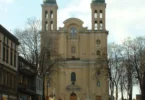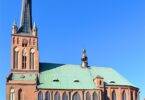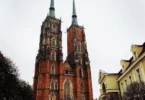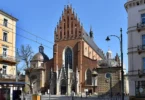Introduction
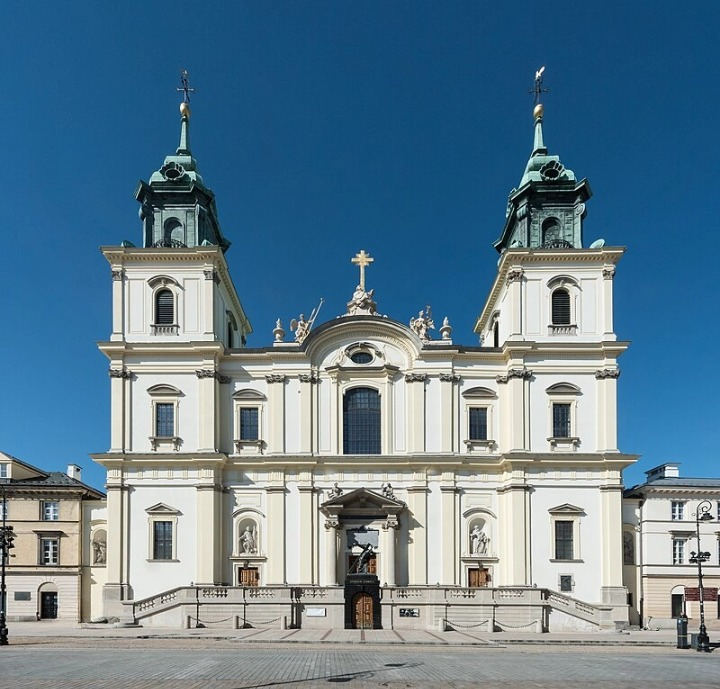
The Church of the Holy Cross in Warsaw (in Polish: Bazylika Świętego Krzyża) is a well-known Roman Catholic Church right in the heart of the city. You’ll find it on Krakowskie Przedmieście, just across from the main entrance to Warsaw University. It’s one of the most famous Baroque churches in the city not just because of its architecture, but also because it holds something really special: the heart of the composer Frédéric Chopin is sealed inside one of its pillars. The church sits at 3 Krakowskie Przedmieście Street, in the Śródmieście district, and it’s currently looked after by the Vincentian Fathers, also known as the Congregation of the Mission. The place has a lot of history and character, and it’s still an active church that draws locals and visitors alike.
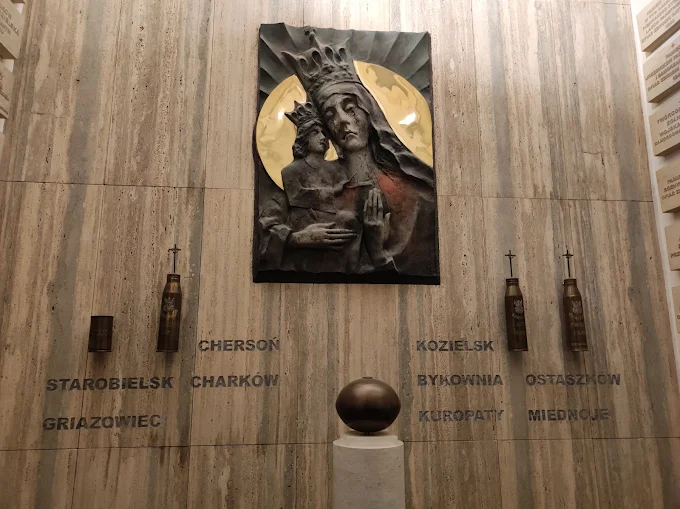
In 1510, it was mentioned that a chapel devoted to the Holy Cross once stood here. In 1525, a small church (according to various sources: wooden or brick) was built here a branch of the collegiate church of St. John, funded by Marta Möller, the widow of Warsaw councilor Serafin Möller. In 1615, the church was rebuilt. Jan Wyk, the Bishop of Pozna, established the wistokrzyskie parish in 1626. By order of Kazimierz Florian Czartoryski, Bishop of Pozna, on December 1, 1653, the church and parish were given to the missionaries of St. Vincent de Paul, who were brought here at the request of King John Casimir’s wife, Queen Louise Maria Gonzaga. From then on, the church became the central house of the Congregation of the Mission in Poland. After the destruction caused by the Swedish Deluge, a decision was made to build a new church. It was constructed in the Baroque style between 1679 and 1696. Its designer was the royal court architect, the Italian Józef Szymon Bellotti , and the founders were Abbot Kazimierz Jan Szczuka , later Bishop of Chełmno, and Primate Michał Stefan Radziejowski , who consecrated the church on October 14, 1696. Józef Fontana created the late Baroque-style dome-covered towers. The façade (1756 ) was designed by his son Jakub Fontana and is decorated with figures by Jan Jerzy Plersch . It was built during the period when Piotr Hiacynt Śliwicki was the parish priest. In 1704, on the initiative of the then parish priest, later bishop, Michał Bartłomiej Tarło , and the Brotherhood of St. Roch, operating at the church since 1688, the service of bitter lamentations was celebrated here for the first time in Poland. The Church of the Holy Cross was a capital church under Stanislaw August Poniatowski, on par with the Collegiate Church of St. John, due to state ceremonies held there, such as the awarding of the Order of Saint Stanislaus , as well as the ceremonial session of the Four-Year Sejm on the first anniversary of the adoption of the Constitution of May 3rd. The participants then proceeded on a march along Nowy Wiat and Aleje Ujazdowskie to the current Botanical Garden, where the foundation stone for the Temple of Divine Providence was laid. The body of Józef Poniatowski, which had been brought from Leipzig, was buried in the church in September 1814; in 1817, it was taken to Kraków and buried in the Wawel Cathedral. A panic broke out during mass on December 25, 1881, and approximately thirty people were trampled on. A pogrom against the Jewish population resulted from a rumor that the victims were Jews. The church was damaged during the defense of Warsaw in September 1939. The Lord’s Supper by Franciszek Smuglewicz and The Crucifixion by Jerzy Siemiginowski were both destroyed. During the Warsaw Uprising, it was a fortified center of German resistance. The insurgents took over the church on August 23, 1944. On September 6, 1944, the Germans introduced two Goliaths filled with explosives into the church. The detonated vehicles smashed the church’s façade, destroyed the vault over the lower church, the Great Altar, and the altars of St. Roch and St. Vincent van Gogh After the war, the building’s destruction was estimated at approximately 45%. The reconstruction of the temple was completed in 1950. In 1965, among 11th-grade students attending religious education classes at the Holy Cross parish, the idea of establishing an academic center arose. Although Cardinal Aleksander Kakowski established an academic chaplaincy at St. Anne’s Church in Warsaw on January 4, 1928, after World War II, only informal and secret academic groups existed. In the fall of 1965, students began gathering in the church. The Holy Cross Academic Chaplaincy, formerly the Tree of Life Academic Community, continues to exist today. In 2002, Pope John Paul II raised the Church of the Holy Cross to the dignity of a minor basilica.
Architecture of Basilica of the Holy Cross, Warszawa, Poland
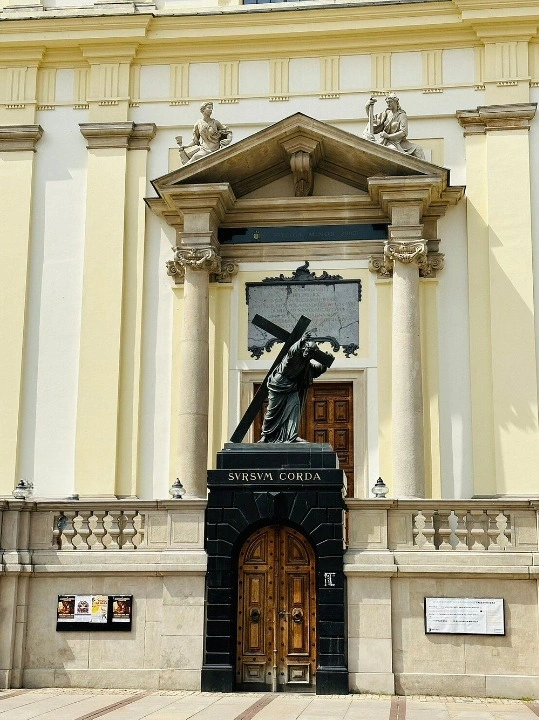
Architect : Simone Giuseppe Belotti.
Architectural style: Baroque architecture.
Figure of Christ
Back in 1858, a statue of Christ carrying the cross was put up in front of the church. It was made out of cement in Ferrante Marconi’s stucco workshop, based on a design by Andrzej Pruszyński. The whole project was funded by Count Andrzej Zamoyski. But after a few years, cracks started showing in the statue. Eventually, people realized something had to be done. A call for donations went out in the Wędrowiec newspaper so they could have the statue cast in bronze instead. Then, in 1887, something really unfortunate happened a mentally ill man damaged the statue and tore off Christ’s hand. That was the final straw. It pushed the decision forward to finally replace the statue with a bronze version. So, in 1898, Pius Weloński recreated the sculpture in Rome, staying true to the original design but he signed it with his own name. On November 2, the new bronze statue was placed on a fresh black granite pedestal, designed by Stefan Szyller, with the words “Sursum Corda” (“Lift up your hearts”) written in gold. The original cement statue wasn’t just thrown away. It was taken to Kruszyna and placed on the Lubomirski family tomb. Today, you can find it standing in front of the local parish church of St. Matthias the Apostle. Then came the war. In September 1944, during the Goliath tank detonation, the bronze statue of Christ was knocked down. It landed on the pavement, lying there with its hand raised pointing right at the words on the pedestal. A few weeks later, on October 22, the Germans took the statue from Warsaw, planning to melt it down. But they ended up abandoning it along with the monument of Nicolaus Copernicus in a ditch near Hajduki Nyskie. Luckily, Polish soldiers found them. Both statues were brought back to Warsaw and restored by the Łopieński Brothers’ workshop. The Christ statue was reinstalled in front of the church on July 19, 1945. It was a big moment there was even a consecration ceremony attended by President Bolesław Bierut and other officials who had just come from unveiling the Copernicus monument. Years later, Pope John Paul II brought up the story during his first pilgrimage to Poland. In his famous homily at Victory Square on June 2, 1979, he said something that really stuck with people. He talked about how you can’t truly understand the history of the Polish nation without Christ. He said, if we try to leave Christ out of it, we lose the key to understanding who we are. He reminded everyone that during the Warsaw Uprising in 1944 when the city rose up and was left to fall alone it wasn’t just buildings that were buried in the rubble. Christ, carrying his cross, was lying there too. Right there, in front of the church on Krakowskie Przedmieście.
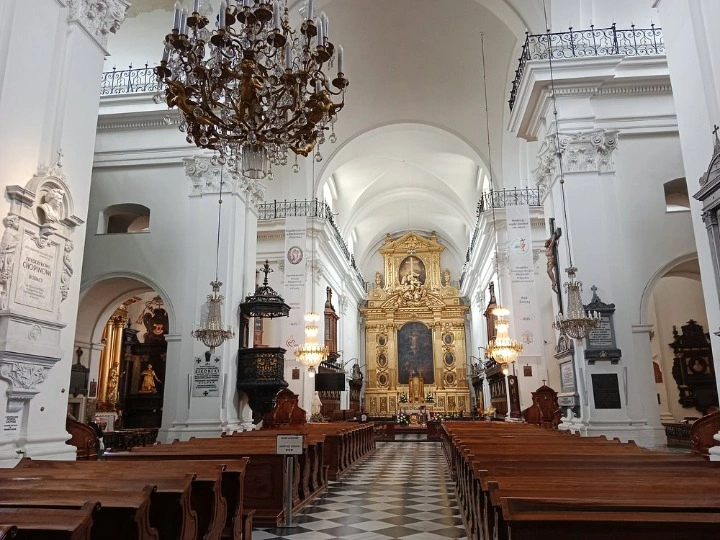
Altars and chapels
Left nave
The Church of St. John Paul II, designed by Professor Bogusaw Smyrski and featuring sculptures by Pawe Pietrusiski, was inaugurated in 2014. the altar of St. Michael the Archangel and the Holy Angels (with a Baroque painting of St. Michael the Archangel in silver robes and figures of St. Raphael, the Guardian Angel and Archangel, was a figure from the early 1800s. St. Joseph’s altar (originally St. Charles Borromeo’s altar ), from the 1730s, with a painting by Adolf Hyła the miraculous artwork depicting St. Jude Thaddeus by Pia Górska from 1938 the altar of From the turn of the 17th and 18th centuries, St. Felicissima was a Roman martyr and the patron saint of the parish of the Holy Cross. It was designed by Tylman van Gameren, funded by the Primate of Poland, Micha Stefan Radziejowski, whose tombstone is located next to this altar, and the saint’s relics were donated by Pope Innocent XII. Chapel of Our Lady of Częstochowa, built in 1700 at the southern wall of the presbytery, with a copy of the painting of Our Lady by Jan Nepomucen Grott (currently a place of adoration of the Blessed Sacrament).
Central nave
The main altar, the so-called Great Altar, originally with woodcarving by Matys Hankis from Elbląg , consecrated in 1696, with a painting (currently a copy) The Crucifixion by Jerzy Eleuter Szymonowicz-Siemiginowski, destroyed in 1944, reconstructed in the years 1960–1972 using original elements Stanislaw Moniuszko, who served as the church’s organist, plays a 19th-century 58-voice organ in the choir. The organ was renovated in 2009–2010.
Right nave
Chapel of Our Lady of Katyn ReconstructedSt. Roch’s altar, which was originally from the first half of the 17th century and was completely destroyed during the war. The altar of St. Vincent de Paul, which was originally the altar of the Sending of the Apostles, was built in the 1730s and completely destroyed during the war. It was rebuilt, and the original painting The Sermon of St. Vincent, around the year 1730 The altar of the Blessed Sacrament (originally the Blessed Sacrament and the Holy Trinity ) the Altar of the Homeland , twin to the altar of Tylman van Gameren’s St. Felicissima was destroyed during the Warsaw Uprising, and it was last rebuilt in the 21st century. The 25th anniversary of John Paul II’s pontificate and the church’s elevation to the status of minor basilica were commemorated with the completion of the church’s reconstruction and the faithful restoration of the altar. In March 2004, at the request of parishioners, John Paul II signed the foundation act for the reconstruction of the altar of the Blessed Sacrament. He also expressed his will that, due to the exceptional significance of the Church of the Holy Cross for Warsaw and all of Poland, it be named the Altar of the Homeland.
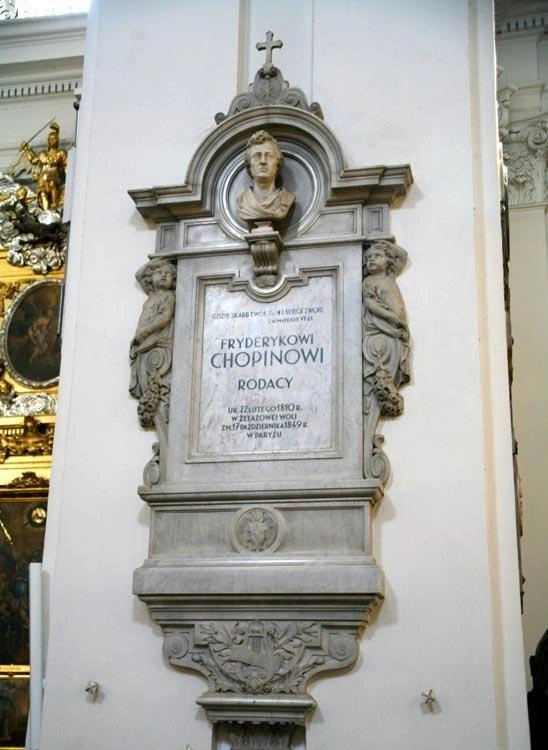
Epitaphs
The pillars inside the church hold urns with the hearts of famous people like Fryderyk Chopin and Władysław Reymont. Chopin’s urn even has a marble epitaph made by Leonardo Marconi, which was put up in 1880. There are also epitaphs for lots of important Polish figures, like Blessed Honorat Koźmiński, Ignacy Krasicki, Zygmunt Krasiński, Adam Mickiewicz, Bolesław Prus, Juliusz Słowacki, and a few others. In one part of the church, you can find the tombstone of Primate Michał Stefan Radziejowski.
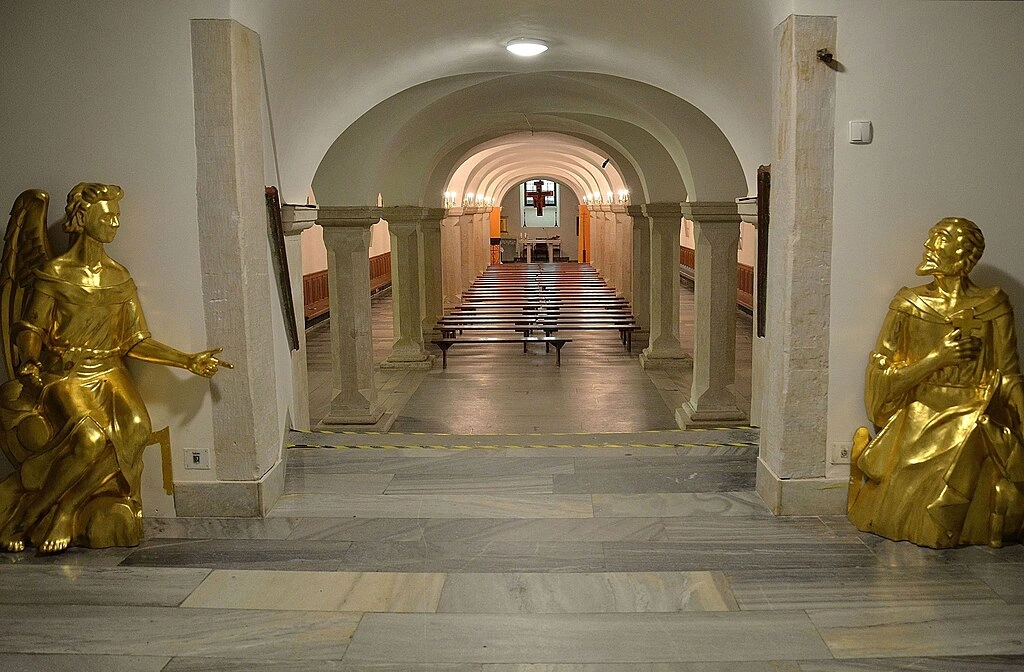
Lower Church
The layout of the lower church is in the shape of an inverted letter T and was completed by 1693. One is immediately struck by the numerous supports and massive pillars that divide the interior into naves of the stark, low room. On both sides of the long corridor running under the nave and leading from the street to the lower church there are crypts with the tombs of, among others, the Marshal of the Great Sejm Stanisław Małachowski , Prince Adam Kazimierz Czartoryski (his marble tombstone is in the Chapel of Our Lady in the upper church) and the missionary and charity activist Father Gabriel Baudoin , called the great almoner of Warsaw. In the catacombs further on in the lower church, the following are buried: Sisters of Mercy and missionary priests, among them the first visitor of the missionary congregation, Bishop of Poznań Michał Bartłomiej Tarło , high-ranking state officials from the times of the Great Sejm , the Duchy of Warsaw and the Kingdom of Poland : the Voivode of Podlasie Stanisław Bernard Gozdzki, the Voivode of Pomerania Jerzy Detloff Flemming , the Voivode of Ruthenia and the Starost of Warsaw August Aleksander Czartoryski , the Starost of Warsaw and Minister of State in the Kingdom of Poland Walenty Faustyn Sobolewski , Minister Tadeusz Dembowski , the charity activist Jan Tadeusz Lubomirski , the economic activist Andrzej Artur Zamoyski , Maria Anna de la Grange d’Arquien Wielopolska, sister of Queen Maria Casimire and wife of Chancellor Jan Wielopolski, and Princess Maria Radziwiłłowa, a philanthropist.
Historical events
In 1683, King Jan III Sobieski entrusted himself and his homeland to God before his expedition to Vienna. On March 14, 1745, the baptism took place of General Casimir Pulaski, Marshal of the Bar Confederation, hero of the struggle for American independence, who died in the Battle of Savannah (1779) from 1765; King Stanisław August Poniatowski awarded the Order of St. Stanislaus in this church every year on the day of his patron saint, May 8. On May 3, 1792, a ceremonial session of the Sejm of the Republic of Poland took place, on the first anniversary of the adoption of the Constitution of May 3, after which a procession set off to Ujazdów to the site of laying the cornerstone for the construction of the Temple of Divine Providence. In 1974, Cardinal Stefan Wyszyski, Primate of Poland, delivered sermons in the church that came to be known as the “witokrzyskie Sermons.” In these sermons, he emphasized the importance of citizens living a dignified life and argued against the omnipotence of the state over its citizens. On the evening of June 13, 1987, Pope John Paul II met with approximately 1,500 representatives of creative communities from all over Poland. The core of the papal homily were words from Cyprian Kamil Norwid’s Promethidion: For beauty is meant to delight, to work-work, so that it may rise from the dead.
Radio Mass
Weekly Mass broadcasts from the Church of the Holy Cross in Warsaw have been available since September 21, 1980. Polish Radio carries the broadcast. In 1980–1982, the Mass reached listeners via Program II (on medium waves). From 1982 to 1989, it was broadcast on ultrashort and long waves on Program IV of Polish Radio, and from 1989 on long waves on Program I of Polish Radio. In August 1980, shipyard workers demanded that mass be broadcast on the radio. The protocol of agreement signed on August 31, 1980, concluded by the Government Commission and the Inter-Enterprise Strike Committee in Gdańsk included a clear provision: The government will ensure radio broadcasting of Sunday mass as part of a detailed arrangement with the Episcopate. Polish Radio Channel I broadcasts mass every Sunday at 9 a.m. at the moment.
Names derived from the church
The church gave its name to the Świętokrzyski farm, founded in the 18th century by missionary priests, and to the now-defunct cemetery around the Church of St. Peter and Paul (St. Barbara’s church) In turn, the farm road that ran through it, today’s Świętokrzyska Street, took its name from the Świętokrzyski farm. In the 20th century, the street gave its name to Świętokrzyski Park (adjacent to the Palace of Culture and Science ), the “Trasa Świętokrzyska” municipal company and the Świętokrzyski Bridge it built , the planned Świętokrzyska Trasa artery extending the bridge, as well as the complex of bus stops and the A-14 Świętokrzyska metro station at the intersection with Marszałkowska Street.
Feast Day
Feast Day : 14 September
The main feast day of the Basilica of the Holy Cross in Warsaw, Poland, is celebrated on September 14th, the Feast of the Exaltation of the Holy Cross. This day holds deep meaning for the parish and its visitors, as it honors the very symbol the church is dedicated to the Cross of Christ.
Church Mass Timing
Monday to Saturday : 6:00 AM , 7:00 AM , 8:00 AM , 9:00 AM , 12:00 PM , 4:30 PM , 6:00 PM , 7:00 PM.
Sunday : 6:00 AM , 7:30 AM , 9:00 AM , 10:30 AM , 11:45 AM , 1:00 PM , 4:00 PM , 7:00 PM.
Church Opening Time:
Monday to Friday, Sunday : 6:00 AM, 8:00 PM.
Saturday : 6:00 AM, 7:00 PM.
Contact Info
Address : Holy Cross Church
Krakowskie Przedmieście 3, 00-047 Warszawa, Poland.
Phone : +48 22 826 89 10
Accommodations
Connectivities
Airway
Basilica of the Holy Cross, Warszawa, Poland, to Warsaw Chopin Airport (WAW), distance between 22m (9.3 km) via Żwirki i Wigury/DW634.
Railway
Basilica of the Holy Cross, Warszawa, Poland, to Warsaw Central Station, distance between 6m (2.0 km) via Świętokrzyska and Marszałkowska.


